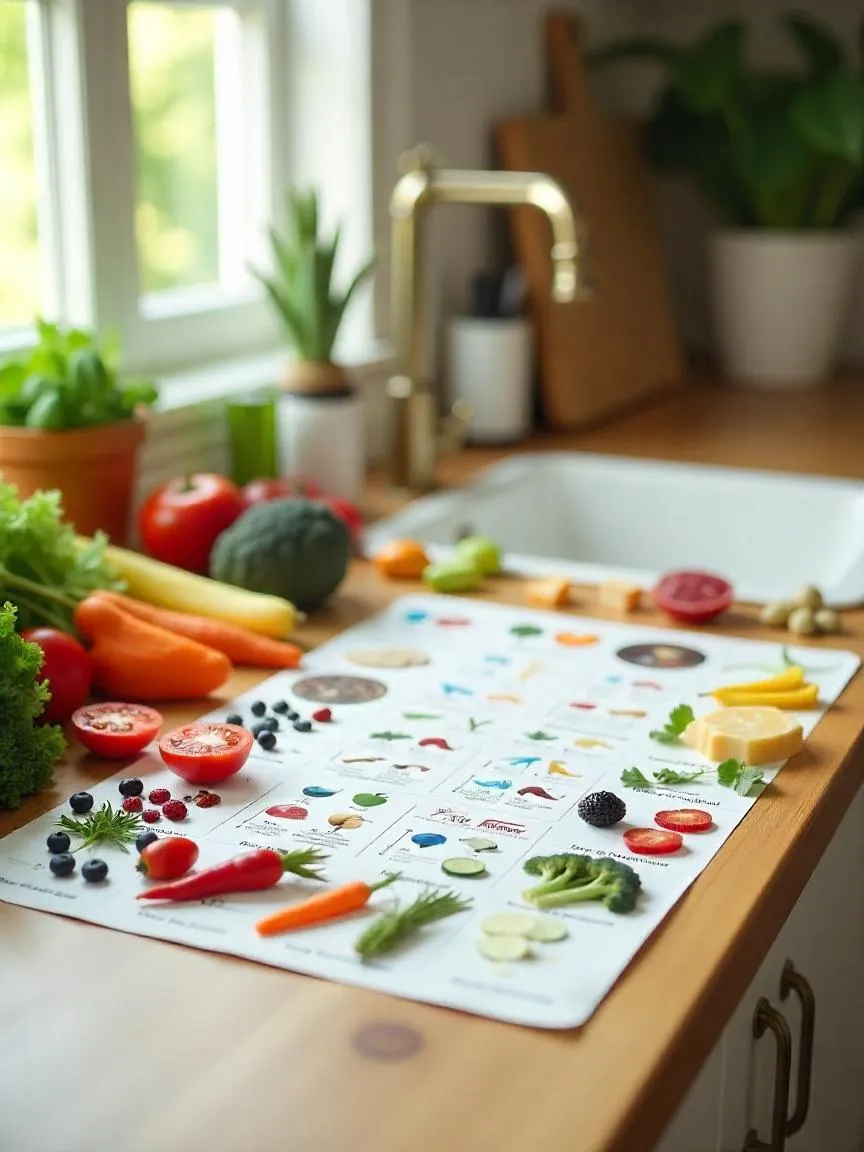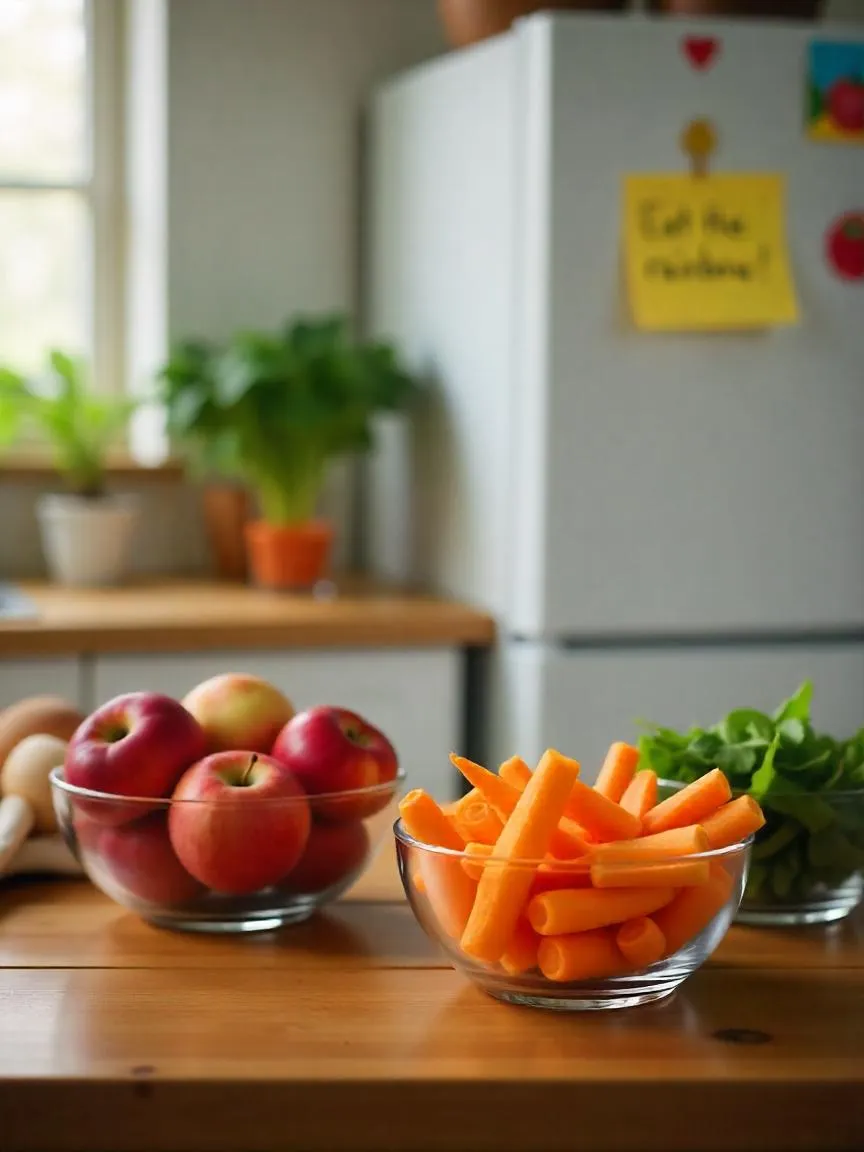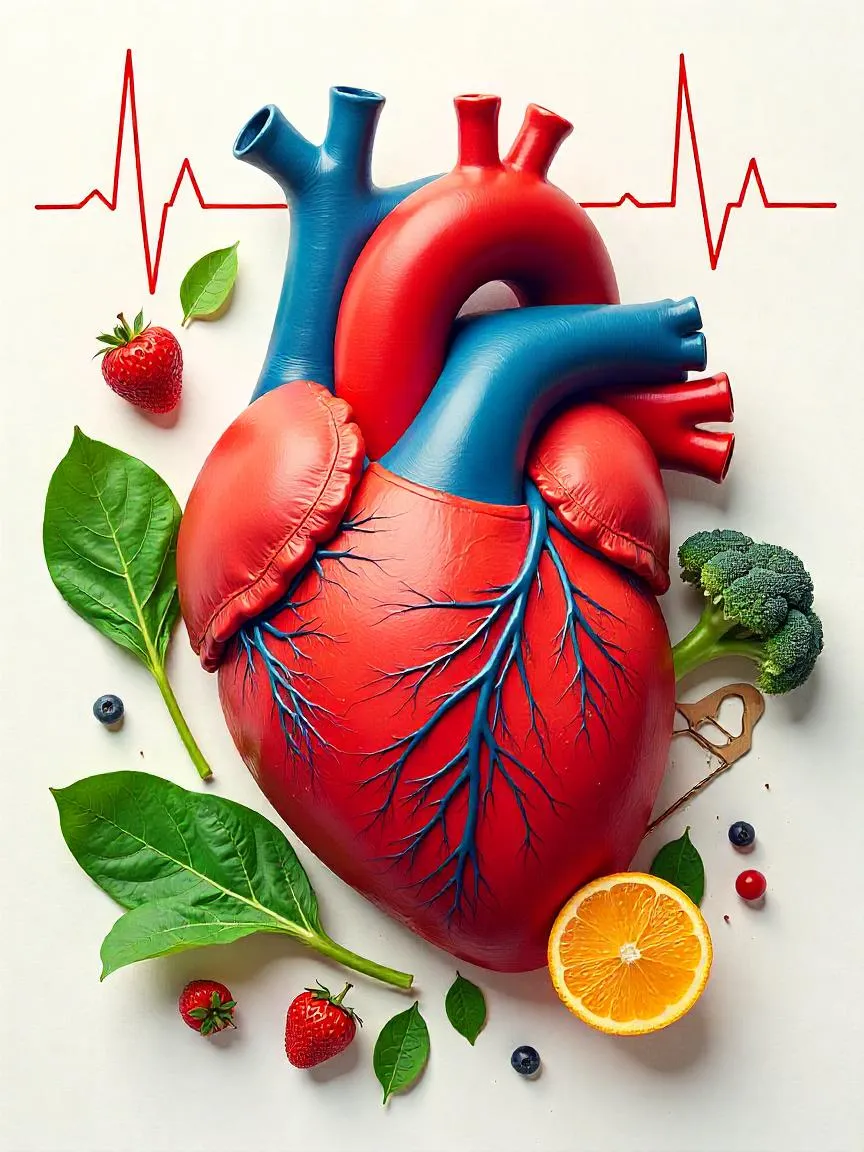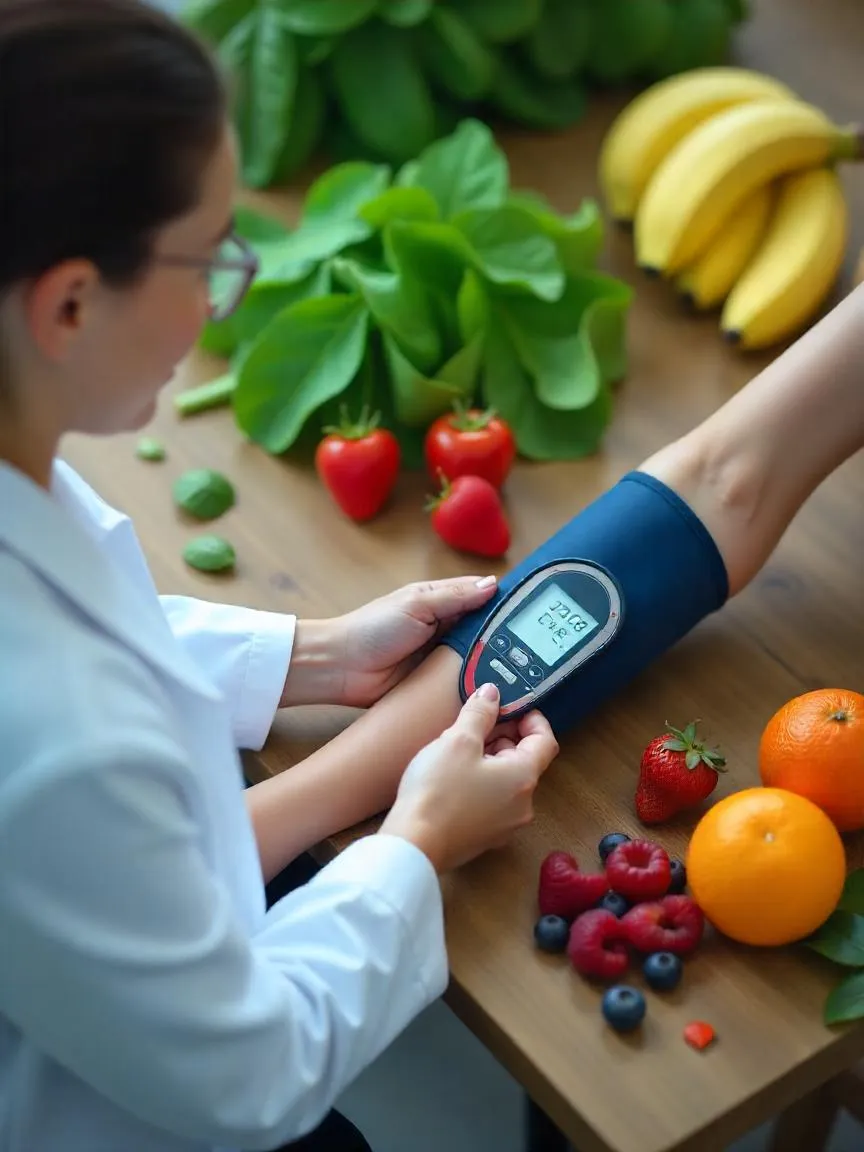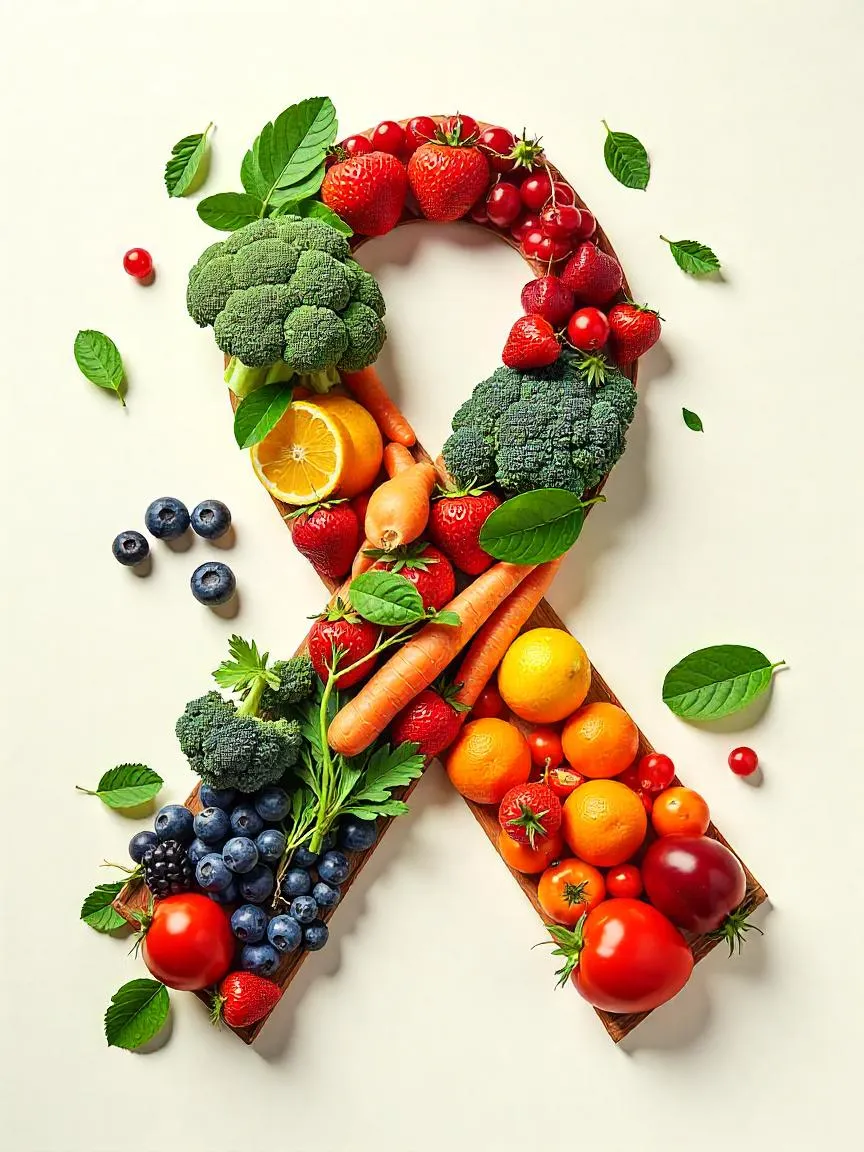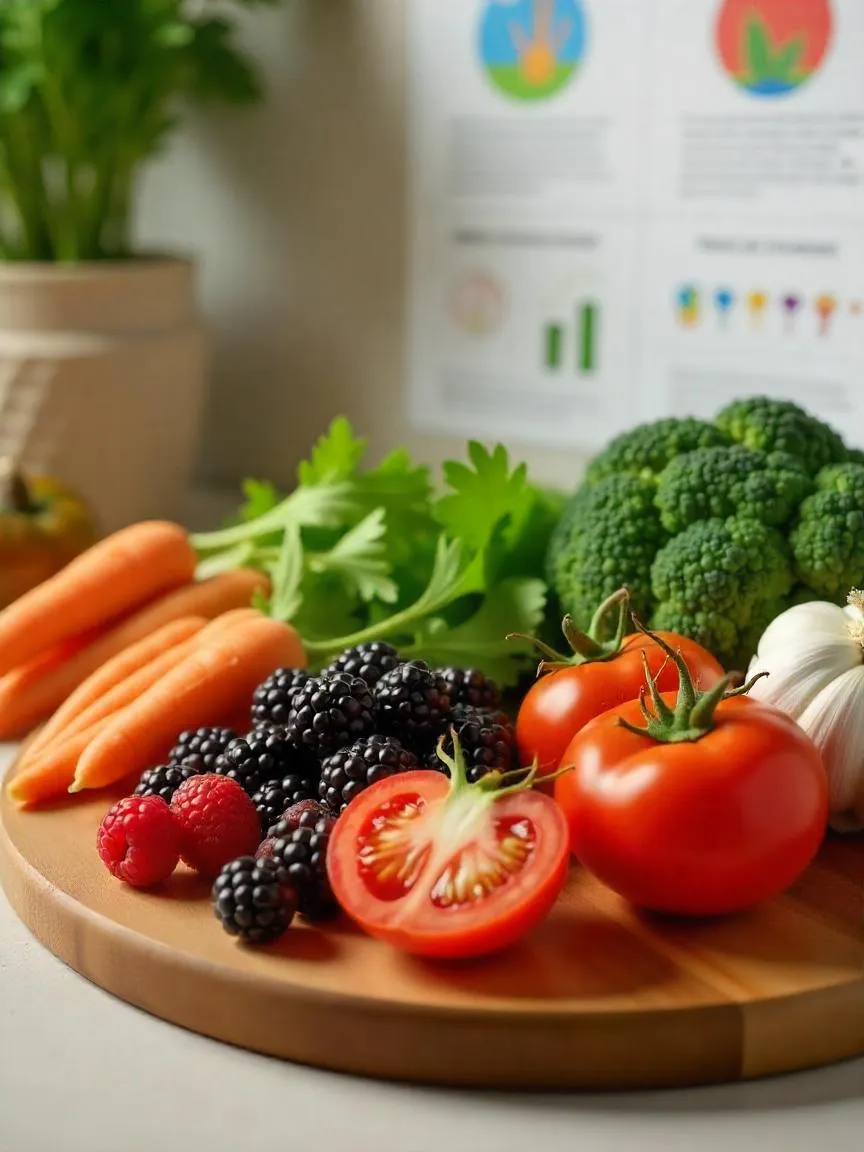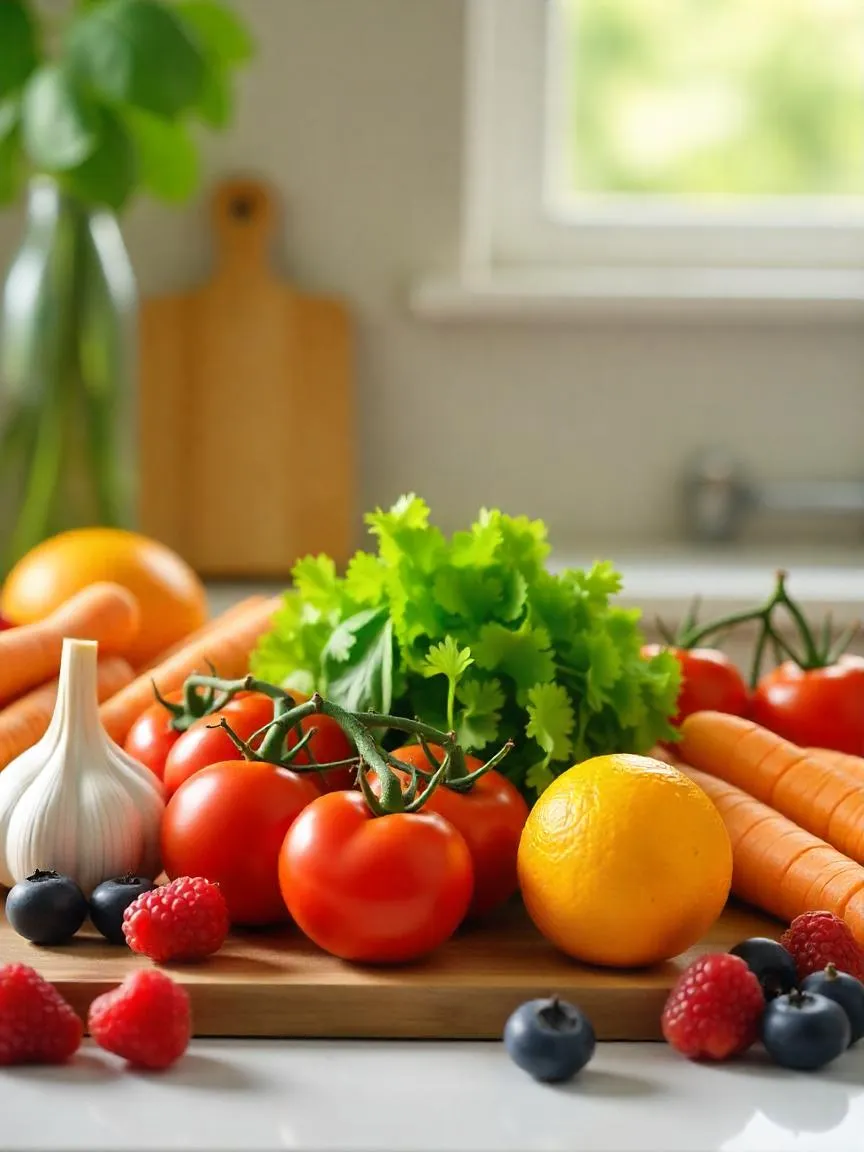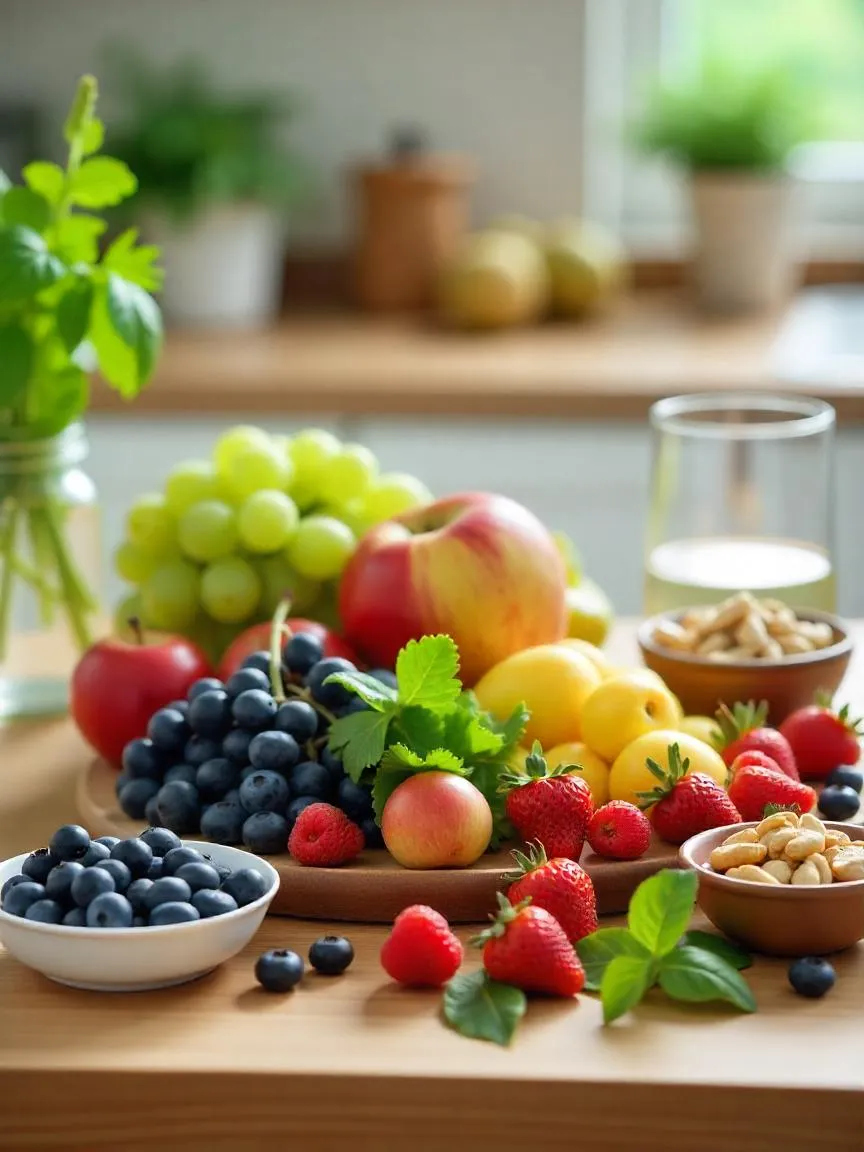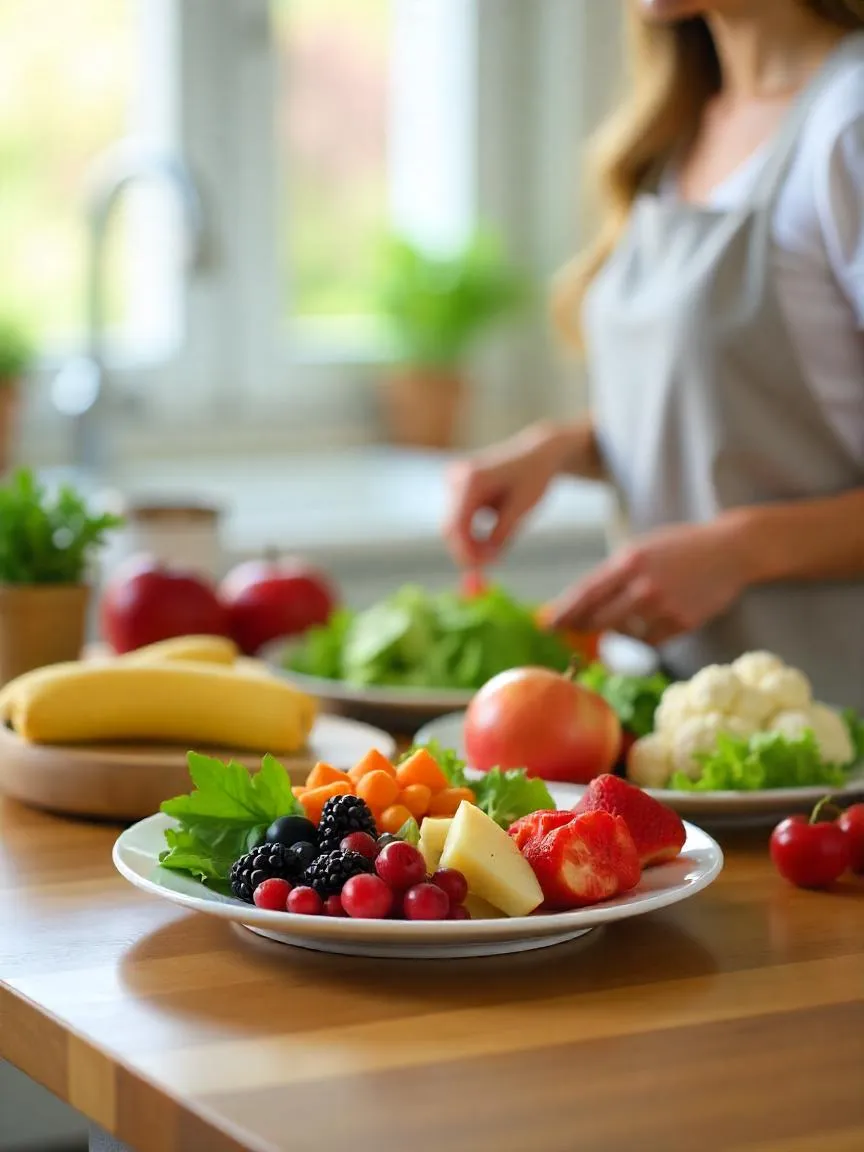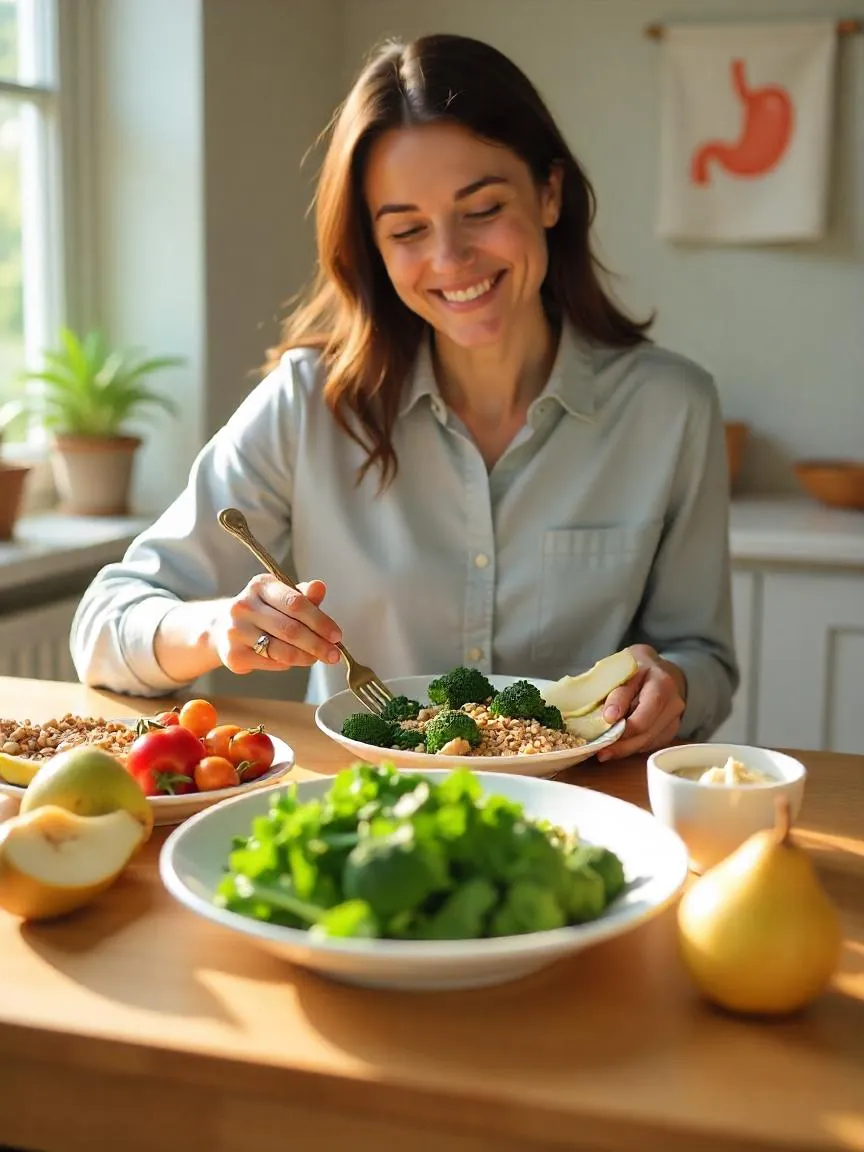Contents
- 🌱 Why Are Vegetables and Fruits So Important?
- 🌈 Variety Means Nutrient Diversity
- 🥕 Tips to Eat More Vegetables and Fruits Each Day
- ❤️ Vegetables, Fruits, and Disease Prevention
- 🩺 Blood Pressure and a Plant-Rich Diet
- 🎗️ Fruits, Vegetables, and Cancer: What the Research Says
- 🥦 Fruits, Vegetables, and Cancer: A Closer Look at the Evidence
- 🍅 Cancer-Fighting Nutrients in Fruits and Vegetables
- 🍇 Vegetables, Fruits, and Type 2 Diabetes
- ⚖️ Weight Management and Fruits & Vegetables
- 💩 Gastrointestinal Health
- 👀 Vision Protection
Vegetables and fruits are a core part of a healthy diet—and variety matters as much as quantity.
A single fruit or vegetable can’t give your body everything it needs. That’s why nutrition experts recommend enjoying a colorful mix of produce every day.
🌱 Why Are Vegetables and Fruits So Important?
A diet rich in fruits and vegetables offers powerful health benefits:
- Lowers blood pressure
- Reduces the risk of heart disease and stroke
- Helps prevent some types of cancer
- Improves digestive health
- Supports healthy vision
- Stabilizes blood sugar levels
→ This helps manage hunger and may aid in weight loss—especially when choosing non-starchy options like leafy greens, apples, and pears.
🌈 Variety Means Nutrient Diversity
There are at least nine distinct plant families of fruits and vegetables, and each offers a unique mix of vitamins, minerals, and disease-fighting compounds.
Eating a rainbow of produce ensures:
- A greater variety of phytonutrients
- A broader nutritional profile
- More interesting and appetizing meals
For example:
- Orange and yellow fruits/veggies (like carrots and mangoes) are rich in beta-carotene.
- Green ones (like spinach and broccoli) offer folate and fiber.
- Blue/purple options (like blueberries and eggplant) contain antioxidants like anthocyanins.
- Red choices (like tomatoes and strawberries) provide lycopene and vitamin C.
🥕 Tips to Eat More Vegetables and Fruits Each Day
Incorporating more produce into your daily routine doesn’t have to be hard—small changes can lead to big health benefits. Here are simple and effective ways to boost your intake:
🍎 1. Keep Fruit Visible and Ready
- Place a bowl of fresh, ready-to-eat fruits on the counter or kitchen table.
- Store washed and cut fruit in clear containers in the fridge—more visible = more likely to eat!
🛒 2. Explore and Experiment
- Stroll through the produce aisle and try something new regularly.
- Aim to include at least one daily serving from each category:
- 🥬 Dark leafy greens (e.g., kale, spinach)
- 🧡 Yellow or orange produce (e.g., sweet potatoes, mangoes)
- 🍓 Red fruits and vegetables (e.g., strawberries, tomatoes)
- 🫘 Legumes and peas
- 🍊 Citrus fruits (e.g., oranges, grapefruits)
🥔 3. Skip the Potatoes
- Potatoes, especially when fried, digest quickly and raise blood sugar.
- Swap them out for fiber-rich, slower-digesting vegetables like broccoli, carrots, or squash.
🍲 4. Make It Part of the Meal
- Add veggies to everyday meals—think stir-fries, soups, stews, grain bowls, or even smoothies.
- Try new recipes focused on produce, like hearty salads, roasted vegetable medleys, or plant-based pastas.
❤️ Vegetables, Fruits, and Disease Prevention
🫀 Cardiovascular Disease
There is strong scientific evidence that eating plenty of fruits and vegetables significantly reduces the risk of heart disease and stroke.
📊 What the Research Says
- A meta-analysis of studies involving 469,551 participants found that each additional daily serving of fruits and vegetables reduced cardiovascular disease mortality by 4%.
- The Nurses’ Health Study and Health Professionals Follow-up Study tracked nearly 110,000 people over 14 years.
- Those who ate 8 or more servings of fruits and vegetables daily had a 30% lower risk of heart attack or stroke than those who ate fewer than 1.5 servings.
- Leafy greens (lettuce, spinach, Swiss chard, mustard greens) showed the strongest link to heart protection.
- Cruciferous vegetables (broccoli, Brussels sprouts, cabbage, kale, bok choy) and citrus fruits (oranges, grapefruit, lemons, limes) also made notable contributions to lower risk.
- When data from U.S. and European studies were combined:
- People eating more than 5 servings/day had about a 20% lower risk of both coronary heart disease and stroke than those eating fewer than 3 servings.
🩺 Blood Pressure and a Plant-Rich Diet
Fruits and vegetables don’t just support heart health—they also play a key role in lowering blood pressure, a major risk factor for heart disease and stroke.
🔬 What the Research Shows
- The DASH (Dietary Approaches to Stop Hypertension) study found that a diet rich in fruits, vegetables, and low-fat dairy, and low in saturated fat:
- Lowered systolic blood pressure by about 11 mm Hg
- Lowered diastolic blood pressure by nearly 6 mm Hg
- These reductions are comparable to the effect of some medications.
- The OmniHeart Trial [7] showed even greater improvements when part of the carbohydrates in the DASH diet were replaced with:
- Healthy unsaturated fats or
- Plant-based protein
- A 2014 meta-analysis of both clinical trials and observational studies found that vegetarian diets were associated with significantly lower blood pressure.
🎗️ Fruits, Vegetables, and Cancer: What the Research Says
Early studies suggested a strong link between high fruit and vegetable consumption and lower cancer risk, but more recent and robust research paints a more nuanced picture.
🧪 Key Research Findings
- Initial case-control studies showed that people who ate more fruits and vegetables appeared to have a lower risk of certain cancers.
- However, cohort studies—which are more reliable because they follow large groups of healthy people over time—have not consistently confirmed this protective effect.
- In the Nurses’ Health Study and the Health Professionals Follow-up Study, people who consumed 8+ servings of fruits and vegetables daily over 14 years were just as likely to develop cancer as those who ate fewer than 1.5 servings.
- A meta-analysis of cohort studies also found no clear reduction in cancer mortality among those with higher fruit and vegetable intake.
📝 Summary
While fruits and vegetables are critical for overall health and play a strong role in heart health, weight control, and diabetes prevention, the evidence for cancer prevention is less consistent. Still, their high nutrient and fiber content makes them a valuable part of any cancer-preventive eating pattern.
🥦 Fruits, Vegetables, and Cancer: A Closer Look at the Evidence
While broad studies have not consistently linked total fruit and vegetable intake to overall cancer prevention, newer research suggests that specific types of produce may offer protection against certain cancers—especially when consumed during earlier stages of life.
👩⚕️ Long-Term Studies on Breast Cancer Risk
Recent findings from the Nurses’ Health Study II provide valuable insights:
- Teen fruit intake matters: Women who ate ~3 servings of fruit daily during adolescence had a 25% lower risk of developing breast cancer later in life compared to those who consumed only 0.5 servings/day. Protective fruits included:
- Apples
- Bananas
- Grapes
- Corn (during adolescence)
- Oranges and kale (during early adulthood)
- Fruit and vegetable fiber is beneficial: High fruit fiber intake during adolescence and early adulthood was linked to a 12% reduction in breast cancer risk; vegetable fiber showed an 11% reduction.
- In a 30-year follow-up of over 180,000 women, those who ate more than 5.5 servings of fruits and vegetables daily had an 11% lower risk of developing breast cancer, particularly aggressive types like:
- Estrogen-receptor-negative tumors (15% lower risk with every 2 extra veggie servings/day)
- HER2-enriched and basal-like tumors
🌱 What the Global Evidence Says
According to the World Cancer Research Fund and American Institute for Cancer Research:
- Non-starchy vegetables (leafy greens, broccoli, bok choy, cabbage, garlic, onions) probably protect against cancers of the:
- Mouth
- Throat
- Voice box
- Esophagus
- Stomach
- Fruits probably protect against lung cancer.
🍅 Cancer-Fighting Nutrients in Fruits and Vegetables
Beyond fiber and vitamins, certain natural plant compounds may actively protect against cancer. Researchers are studying how these bioactive compounds work—and which foods contain the most benefit.
🔬 Lycopene and Prostate Cancer
A notable example is lycopene, a powerful antioxidant pigment that gives tomatoes their rich red color.
- Research from the Health Professionals Follow-up Study has shown a potential link between higher tomato intake and a lower risk of prostate cancer, especially more aggressive forms.
- Lycopene is more available in cooked tomato products (like tomato sauce or paste) than in raw tomatoes.
- Although not all studies agree on the strength of this link, the overall evidence suggests a protective role of lycopene-rich foods in prostate health.
🥕 Carotenoids: Nature’s Antioxidants
Lycopene is part of a broader group of nutrients called carotenoids, which include:
- Beta-carotene (found in carrots, sweet potatoes, pumpkin)
- Lutein and zeaxanthin (in dark leafy greens like spinach and kale)
- Alpha-carotene (in carrots, winter squash, peas)
These compounds are known for their antioxidant properties and their role in promoting cell health. They may contribute to reduced risk of cancers affecting the:
- Lungs
- Mouth
- Throat
However, researchers note that it’s the whole food package—rather than isolated supplements—that appears to offer the most protection. More studies are needed to clarify how these compounds work in the body.
🍇 Vegetables, Fruits, and Type 2 Diabetes
Mounting evidence suggests that whole fruits and vegetables—especially those rich in fiber and phytochemicals—may help lower the risk of type 2 diabetes.
🍎 Whole Fruits vs. Fruit Juice
In a large pooled analysis of three long-term studies—including more than 187,000 adults from the Nurses’ Health Studies and the Health Professionals Follow-up Study—researchers found:
- Greater consumption of whole fruits, especially blueberries, grapes, and apples, was linked to a lower risk of type 2 diabetes.
- Higher consumption of fruit juice was associated with a higher risk of developing diabetes.
This suggests that whole fruits, with their fiber and slower digestion, help maintain stable blood sugar—while juices, which are rapidly absorbed and often stripped of fiber, may cause spikes in blood sugar.
🥬 Leafy Greens & Diabetes Risk
Another study of more than 70,000 women aged 38–63 found that:
- Eating more green leafy vegetables and fruits was significantly associated with a lower risk of type 2 diabetes.
- Again, fruit juice was linked with an increased risk, reinforcing the message to opt for whole fruit over liquid alternatives.
🍓 Berries and Blood Sugar
A smaller study involving 2,300 Finnish men found that diets high in berries were linked to a reduced risk of type 2 diabetes. Berries like bilberries, lingonberries, and blackcurrants—common in Nordic diets—may offer unique protective effects due to their high antioxidant and polyphenol content.
⚖️ Weight Management and Fruits & Vegetables
Long-term data from the Nurses’ Health Studies and the Health Professionals Follow-up Study show that people who increased their intake of fruits and vegetables over 24 years were more likely to experience weight loss than those who kept their intake the same or decreased it.
🍓 Fruits and Veggies Linked with Weight Loss:
- Berries
- Apples
- Pears
- Cauliflower
- Soy foods
🥔 Vegetables Linked with Weight Gain:
- Potatoes
- Corn
- Peas
📝 Important Note: Simply adding more fruits and vegetables won’t lead to weight loss unless they replace more calorie-dense foods—especially refined carbohydrates like white bread, crackers, or sugary snacks.
💩 Gastrointestinal Health
Fruits and vegetables are rich in indigestible fiber, which plays a key role in digestive well-being:
- Insoluble fiber adds bulk and helps regulate bowel movements, preventing constipation.
- It lowers intestinal pressure, which may help prevent conditions like diverticulosis.
- For those with irritable bowel syndrome (IBS), fiber can ease symptoms by promoting smoother digestion.
👀 Vision Protection
A colorful plate benefits more than your waistline—it supports your eye health, too.
- Lutein and zeaxanthin—found in leafy greens and brightly colored vegetables—may help reduce the risk of:
- Cataracts
- Age-related macular degeneration (AMD)
These two eye conditions are among the leading causes of vision impairment in older adults. A fruit- and vegetable-rich diet may provide a natural defense.


